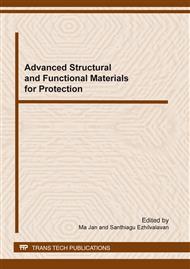p.106
p.109
p.113
p.116
p.119
p.122
p.126
p.129
p.133
Fabrication and Characterization of Electrospun Nano to Microfiber Made of Poly(L-Lactide-co-ε-Caprolactone)
Abstract:
This project aims to optimize the process parameters for fabricating Poly (L-Lactide-co-ε-Caprolactone) (PLCL) electrospun scaffolds to achieve fiber diameters within the ranges of ~500nm, 500nm~1µm and 1~3µm. Electronspun PLCL solutions of different concentrations (4wt% - 12wt%) were prepared using chloroform and dimethylformamide as solvents. The driving voltage and flow rate were varied from 10kV-30kV and 1ml/hr12ml/hr respectively while the gap distance was kept constant at 15cm. The effects of polymer concentration and process parameters on the properties of the scaffolds fabricated such as Youngs modulus, degree of crystallization and porosity were studied. Scanning electron microscopy (SEM) was used to check the structural integrity (absence of beading and uniform diameter) of the fibers. An increase in polymer concentration resulted in an increase in fiber diameter. Flow rate also showed a positive correlation with fiber diameter. Results showed that Youngs modulus decreased with increasing fiber diameter. Porosity of 76% to 94% was achieved. The potential application of PLCL electrospun scaffolds in the tissue engineering of soft tissues was discussed.
Info:
Periodical:
Pages:
122-125
Citation:
Online since:
February 2012
Price:
Сopyright:
© 2012 Trans Tech Publications Ltd. All Rights Reserved
Share:
Citation:


